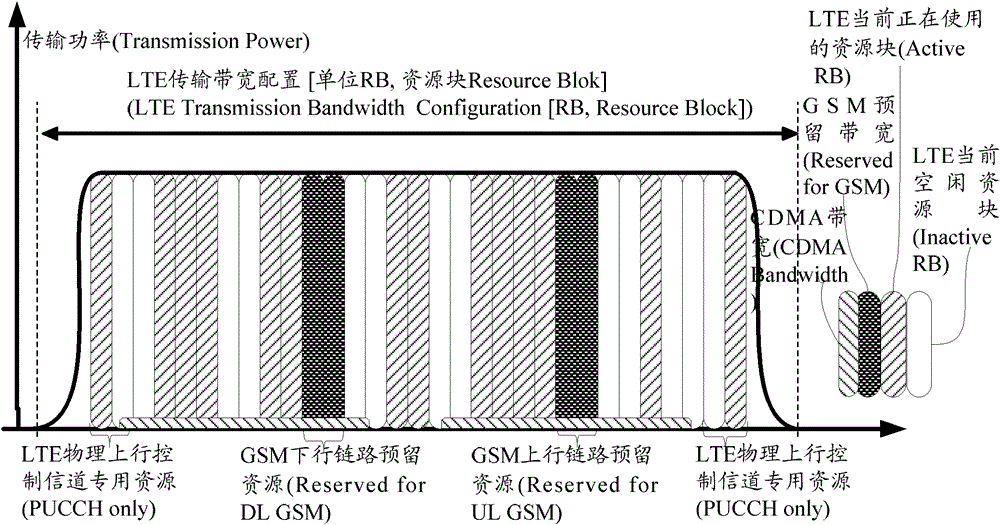Dual network common mode method and system
A common mode, LTE-A technology, applied in the field of communication, can solve the problems of low spectral efficiency, low frequency band cannot be effectively used, and spectral efficiency has no contribution, so as to reduce construction cost and hardware manufacturing cost, work risk and implementation The effect of low difficulty and reducing the number of launch channels
- Summary
- Abstract
- Description
- Claims
- Application Information
AI Technical Summary
Problems solved by technology
Method used
Image
Examples
Embodiment 1
[0043] This embodiment takes CDMA and LTE common mode as an example, where the CDMA system can be WCDMA, CDMA1x, TD-SCDMA, etc. The specific steps are as follows:
[0044] Step 1, determining the CDMA and LTE system frequency band superposition mode;
[0045] Let LTE uplink frequency band ULBW, downlink frequency band DLBW; and CDMA forward link frequency band FLBW, reverse link frequency band RLBW, for TD-SCDMA, FLBW and RLBW are the same frequency band;
[0046] Superimpose FLBW and RLBW on one or two frequency bands of LTE to ensure that FLBW and RLBW do not overlap, attach figure 1 , 2 Two superposition methods are given;
[0047] Step 2, limiting the maximum received PSD of the signal on the frequency band where the LTE and CDMA signals are superimposed;
[0048] Let LTE receive PSD be PSDRxL (unit is dBm), PSD of CDMA system is PSDRxC (unit is dBm), and the signal detection threshold of CDMA system is SINRC (unit is dB), then:
[0049] PSDRxC-PSDRxL-Noise>=SINRC+Inte...
Embodiment 2
[0054] This embodiment takes CDMA and LTE-A common mode as an example, where the CDMA system can be WCDMA, CDMA1x, TD-SCDMA, etc. The specific steps are as follows:
[0055] Step 1, determining the CDMA and LTE-A system frequency band superposition mode;
[0056] Let LTE-A uplink frequency bands ULBW1, ULBW2, ..., ULBWm; downlink frequency bands DLBW1, DLBW2, ..., DLBWn; and CDMA forward link frequency band FLBW, reverse link frequency band RLBW, for TD-SCDMA, FLBW It is the same frequency band as RLBW;
[0057] Superimpose FLBW and RLBW on one or two frequency bands of LTE-A to ensure that FLBW and RLBW do not overlap, image 3 One superposition method is given;
[0058] Step 2, limiting the maximum received PSD of the signal on the frequency band where the LTE-A and CDMA signals are superimposed;
[0059] Let LTE-A receive PSD be PSDRxL (unit is dBm), PSD of CDMA system is PSDRxC (unit is dBm), and the signal detection threshold of CDMA system is SINRC (unit is dB), then:...
Embodiment 3
[0064] This embodiment takes CDMA and LTE / LTE-A common mode as an example, and describes a CDMA and LTE / LTE-A common mode system, as shown in the attached Figure 4 As shown, its composition is described as follows:
[0065] The CDMA and LTE / LTE-A frequency band superposition mode determination unit 401 is used to determine the CDMA and LTE / LTE-A frequency band superposition mode, so as to finally superimpose the CDMA signal on the LTE / LTE-A signal, specifically as follows:
[0066] Let LTE / LTE-A uplink frequency bands ULBW1, ULBW2, ..., ULBWm; downlink frequency bands DLBW1, DLBW2, ..., DLBWn; and CDMA forward link frequency band FLBW, reverse link frequency band RLBW, for TD-SCDMA , FLBW and RLBW are the same frequency band;
[0067] Superimpose FLBW and RLBW on one or two frequency bands of LTE / LTE-A to ensure that FLBW and RLBW do not overlap. Figures 1 to 3 Three superposition methods are given;
[0068] The LTE / LTE-A power control unit 402 is configured to limit the ...
PUM
 Login to View More
Login to View More Abstract
Description
Claims
Application Information
 Login to View More
Login to View More - R&D
- Intellectual Property
- Life Sciences
- Materials
- Tech Scout
- Unparalleled Data Quality
- Higher Quality Content
- 60% Fewer Hallucinations
Browse by: Latest US Patents, China's latest patents, Technical Efficacy Thesaurus, Application Domain, Technology Topic, Popular Technical Reports.
© 2025 PatSnap. All rights reserved.Legal|Privacy policy|Modern Slavery Act Transparency Statement|Sitemap|About US| Contact US: help@patsnap.com



